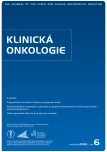Prognostic and predictive factors of brain meningiomas
Authors:
M. Palička 1; M. Wozniaková 2; L. Knybel 1; J. Cvek 1
Authors place of work:
Onkologická klinika LF OU a FN Ostrava
1; Ústav klinické a molekulární patologie a lékařské genetiky LF OU a FN Ostrava
2
Published in the journal:
Klin Onkol 2022; 35(6): 441-447
Category:
Přehled
doi:
https://doi.org/10.48095/ccko2022441
Summary
Background: Common primary brain tumors are meningiomas with year incidence 3–8 cases per 100 000 people. Even though we mainly speak about benign disease, with its character and localization, it worsens the life quality to its bearer. The main therapeutic methods are neurosurgery extirpation and stereotactic radiosurgery. Despite reaching very good therapeutic results with both methods, some of the patients suffer with recurrence of the disease requiring other interventions with the risk of creating or worsening a neurological deficit. Small meningiomas without growing tendency and with the absence of symptomatology are observed. On the other hand, we cannot be satisfied with long-term results of the therapy of meningiomas with more aggressive biological behavior. A higher grade is a known risk of meningioma recurrence; however, it is often difficult to identify subgroups that show advantage of a combination of neurosurgery and radiosurgery, respectfully at which it is appropriate to look for ways to treatment escalation, and that is with the risk of side effects. The analysis of hormonal, cytogenetics and epigenetics tumor equipment seems to be the most promising for the development of personalized treatment. Purpose: The aim of this work is to sum up the facts about epidemiology, treatment algorithms and the prognosis of brain meningiomas and to suggest perspective prognostic and predictive factors for maximally individualized therapy.
Keywords:
Epigenetics – Cytogenetics – Meningioma – Stereotactic radiosurgery
Zdroje
1. Buerki RA, Horbinski CM, Kruser T et al. An overview of meningiomas. Future Oncol 2018; 14 (21): 2161–2177. doi: 102217/fon-2018-0006.
2. Caroline A, Matthieu P, Kalamarides M. Current treatment options for meningioma. Expert Rev Neurother 2018; 18 (3): 241–249. doi: 10.1080/14737175.2018.1429920.
3. Yerrabothala S, Gourley BL, Ford JC et al. Systemic coagulation is activated in patients with meningioma and glioblastoma. J Neurooncol 2021; 155 (2): 173–180. doi: 10.1007/s11060-021-03865-w.
4. Wiemels J, Wrensch M, Claus EB. Epidemiology and etiology of meningioma. J Neurooncol 2010; 99 (3): 307–314. doi: 10.1007/s11060-010-0386-3.
5. Louis DN, Perry A, Reifenberger G et al. The 2016 World Health Organization classification of tumors of the central nervous system: a summary. Acta Neuropathol 2016; 131 (6): 803–820. doi: 10.1007/s00401-016-1545-1.
6. Huntoon K, Toland AMS, Dahiya S. Meningioma: a review of clinicopathological and molecular aspects. Front Oncol 2020; 10 : 579599. doi: 10.3389/fonc.2020.579599.
7. Haddad AF, Young JS, Kanungo I et al. WHO grade I meningioma recurrence: identifying high risk patients using histopathological features and the MIB-1 index. Front Oncol 2020; 10 : 1522. doi: 10.3389/fonc.2020.01522.
8. Fatima N, Meola A, Pollom EL et al. Stereotactic radiosurgery versus stereotactic radiotherapy in the management of intracranial meningiomas: a systematic review and meta-analysis. Neurosurgical Focus 2019; 46 (6): E2. doi: 10.3171/2019.3.FOCUS1970.
9. Rogers L, Zhang P, Vogelbaum MA et al. Intermediate-risk meningioma: initial outcomes from NRG oncology RTOG 0539. J Neurosurg 2018; 129 (1): 35–47. doi: 10.3171/2016.11.JNS161170.
10. Cordova C, Kurz SC. Advances in molecular classification and therapeutic opportunities in meningiomas. Curr Oncol Rep 2020; 22 (8): 84. doi: 10.1007/s11912-020-00937-4.
11. Cohen-Inbar O, Tata A, Moosa S et al. Stereotactic radiosurgery in the treatment of parasellar meningiomas: long-term volumetric evaluation. J Neurosurg 2018; 128 (2): 362–372. doi: 10.3171/2016.11.JNS161 402.
12. Abry E, Thomassen IØ, Salvesen ØO et al. The significance of Ki-67/MIB-1 labeling index in human meningiomas: a literature study. Pathol Res Pract 2010; 206 (12): 810–815. doi: 10.1016/j.prp.2010.09.002.
13. Scholzen T, Gerdes J. The Ki-67 protein: from the known and the unknown. J Cell Physiol 2000; 182 (3): 311–322. doi: 10.1002/ (SICI) 1097-4652 (200003) 182 : 3<311:: AID-JCP1>3.0.CO; 2-9.
14. Nakajo M, Bohara M, Kamimura K et al. Correlation between amide proton transfer-related signal intensity and diffusion and perfusion magnetic resonance imaging parameters in high-grade glioma. Sci Rep 2021; 11 (1): 11223. doi: 10.1038/s41598-021-90841-z.
15. Yoshida K, Miki Y. Role of BRCA1 and BRCA2 as regulators of DNA repair, transcription, and cell cycle in response to DNA damage. Cancer Sci 2004; 95 (11): 866–871. doi: 10.1111/j.1349-7006.2004.tb02195.x.
16. Kanapathipillai M. Treating p53 mutant aggregation-associated cancer. Cancers (Basel) 2018; 10 (6): 154. doi: 10.3390/cancers10060154.
17. Sievers P, Hielscher T, Schrimpf D et al. CDKN2A/B homozygous deletion is associated with early recurrence in meningiomas. Acta Neuropathol 2020; 140 (3): 409–413. doi: 10.1007/s00401-020-02188-w.
18. Suppiah S, Nassiri F, Bi WL et al. International consortium on meningiomas, molecular and translational advances in meningiomas. Neuro Oncol 2019; 21 (Suppl 1): i4–i17. doi: 10.1093/neuonc/noy178.
19. Sahm F, Schrimpf D, Stichel D et al. DNA methylation - based classification and grading system for meningioma: a multicentre, retrospective analysis. Lancet Oncol 2017; 18 (5): 682–694. doi: 10.1016/S1470-2045 (17) 30155-9.
Štítky
Dětská onkologie Chirurgie všeobecná OnkologieČlánek vyšel v časopise
Klinická onkologie

2022 Číslo 6
- Metamizol jako analgetikum první volby: kdy, pro koho, jak a proč?
- Jak souvisí postcovidový syndrom s poškozením mozku?
- Nejasný stín na plicích – kazuistika
- Perorální antivirotika jako vysoce efektivní nástroj prevence hospitalizací kvůli COVID-19 − otázky a odpovědi pro praxi
- Neodolpasse je bezpečný přípravek v krátkodobé léčbě bolesti
Nejčtenější v tomto čísle
- Prognostické a prediktivní faktory meningeomů mozku
- Výhody a omezení 3D organoidů a ex vivo kultivace nádorových tkání v personalizované medicíně pro karcinom prostaty
- Fekální mikrobiální transplantace – nová možnost ovlivnění výsledků terapie onkologických pacientů
- Fatální myokarditida po první dávce nivolumabu
